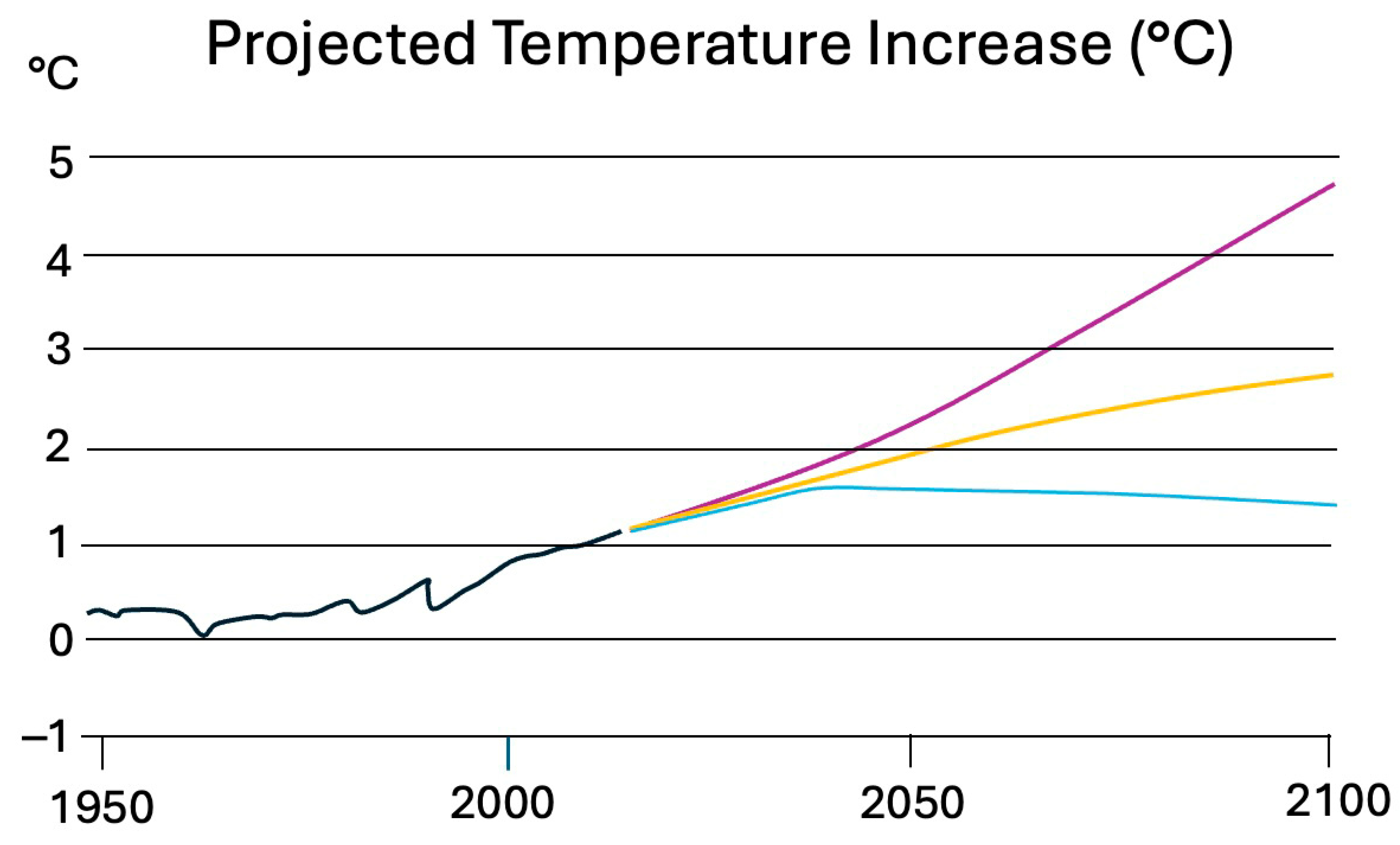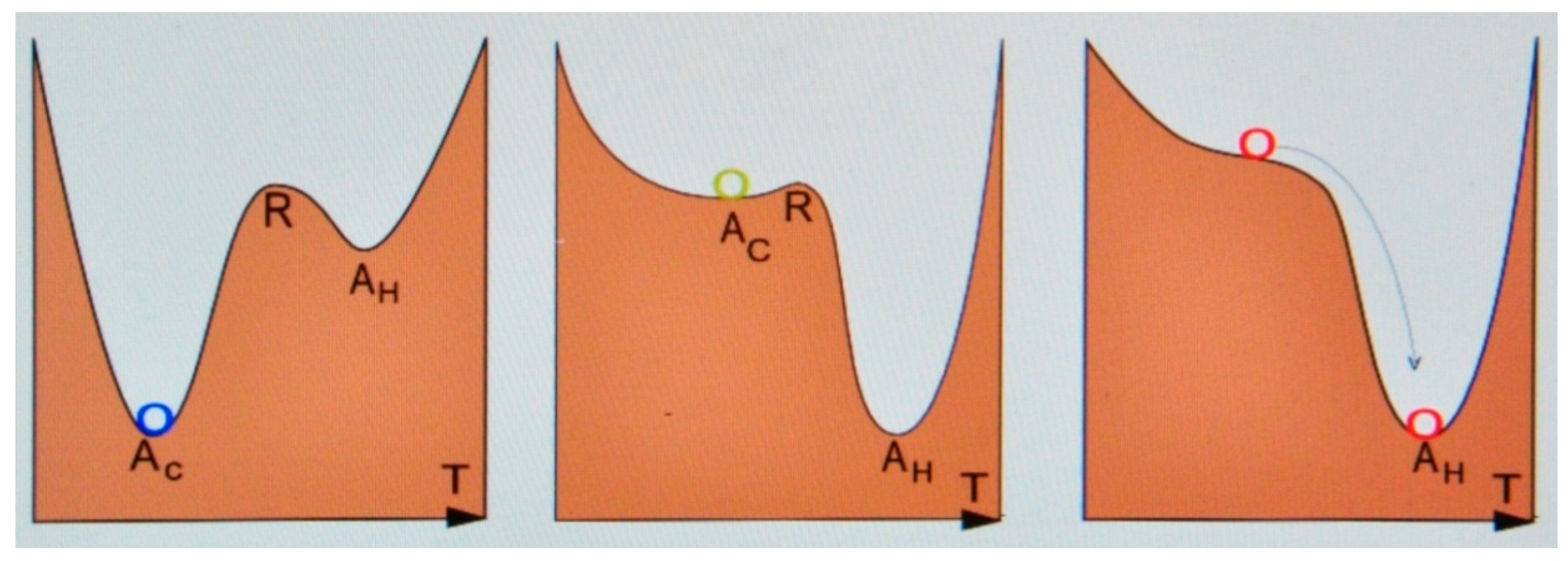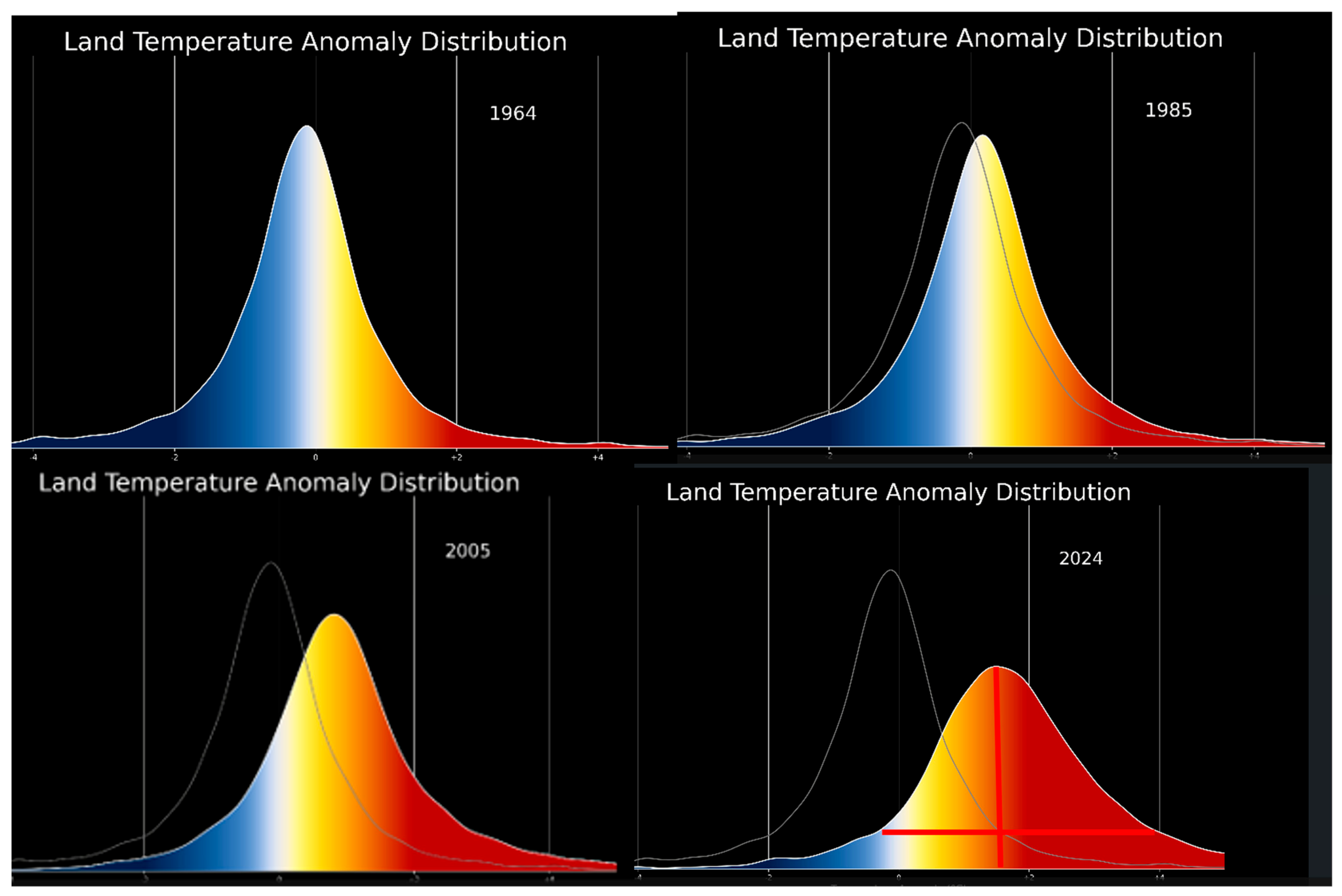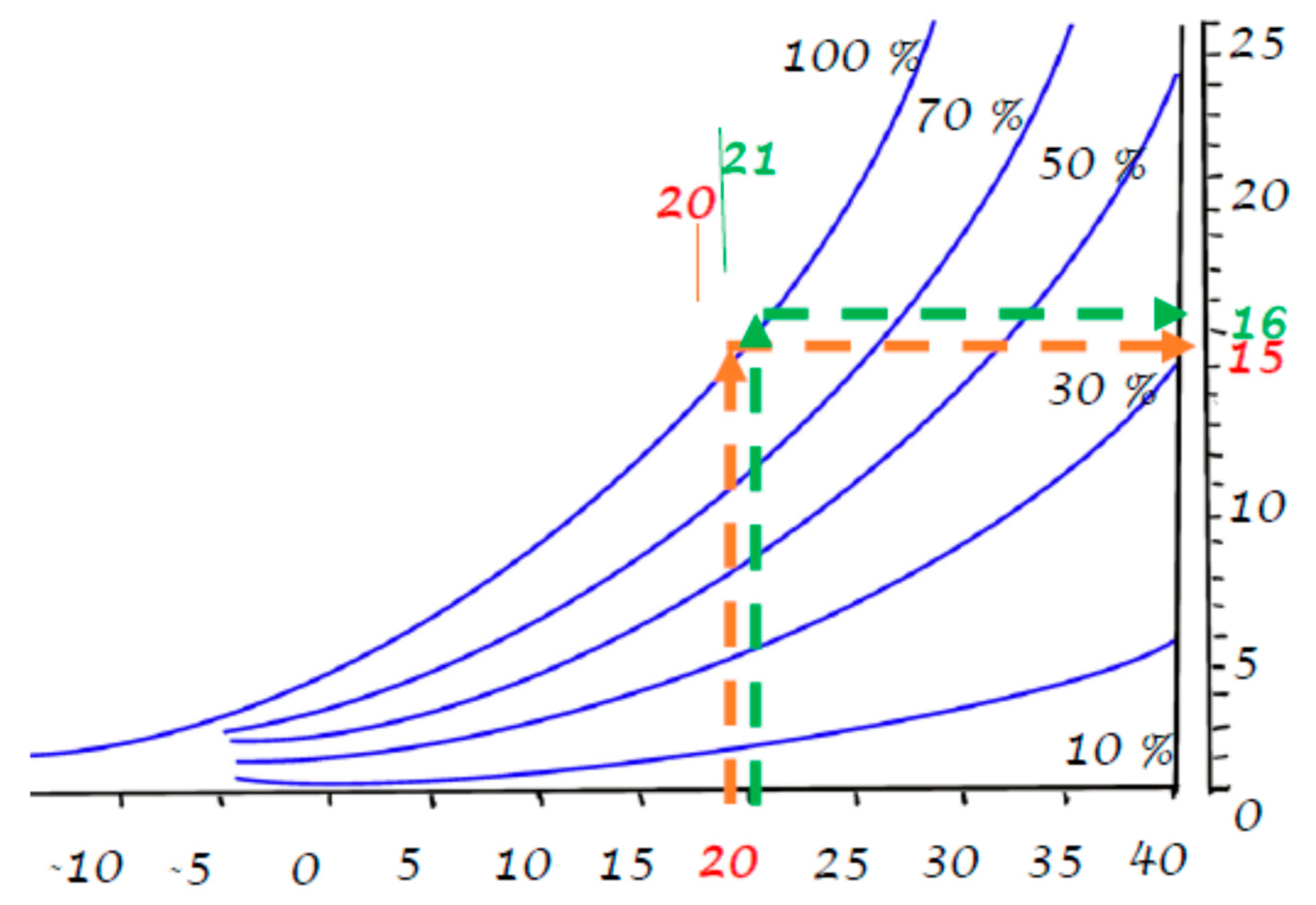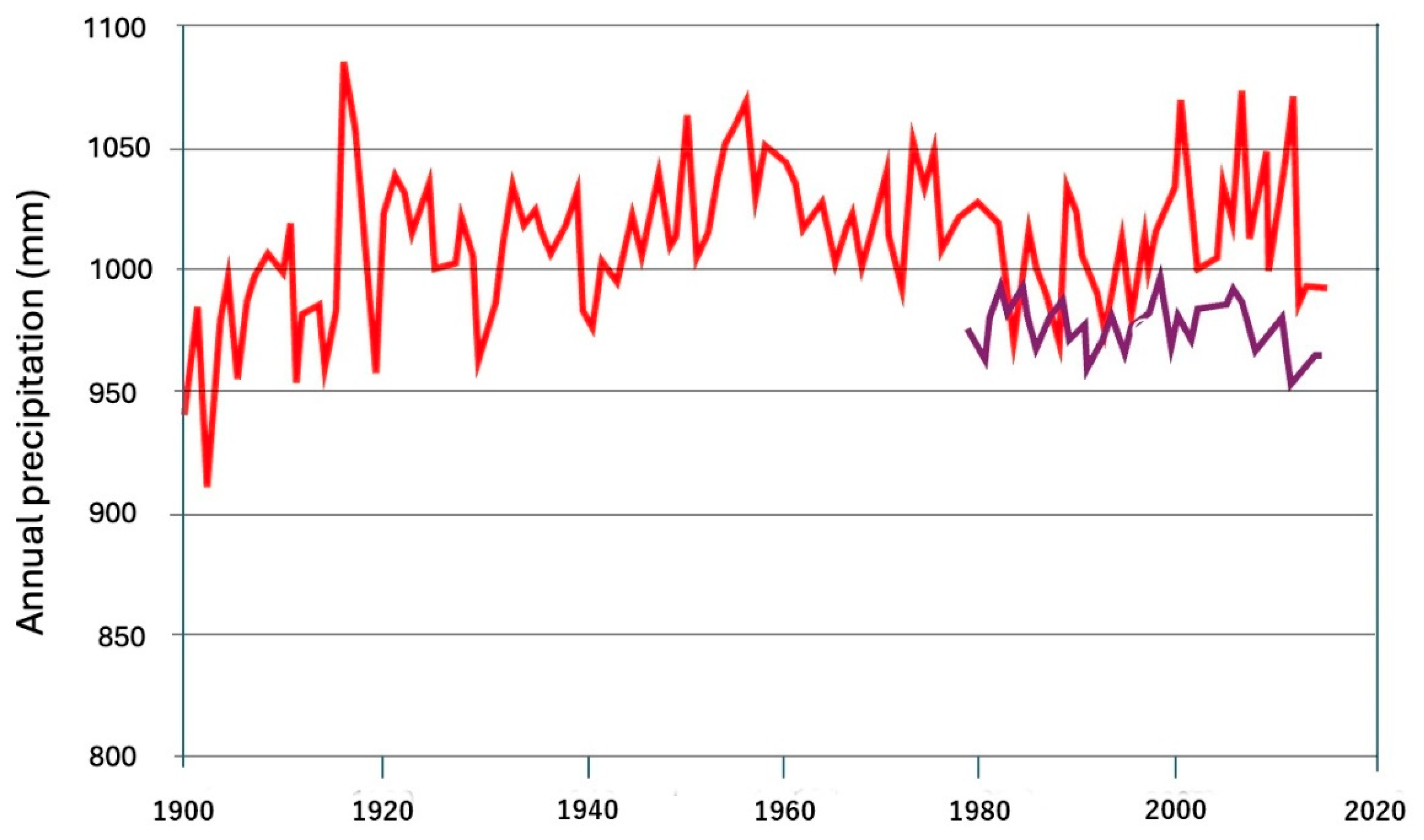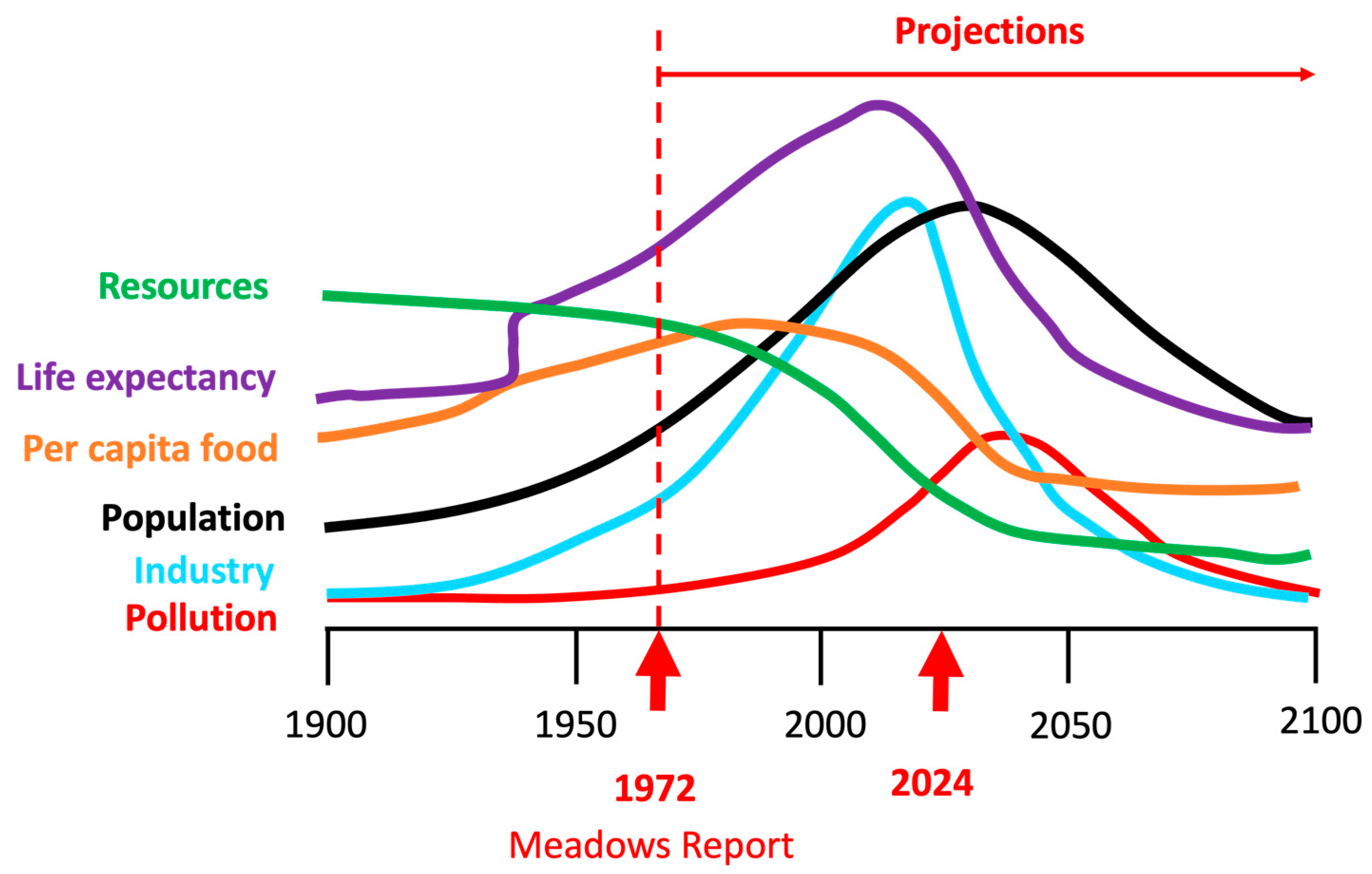1. Introduction
We are experiencing an unprecedented climate crisis, at least at the human scale. In particular, during the last million years, Earth’s surface temperature has fluctuated through a succession of ice ages separated by warmer episodes, with a period of about 100,000 years, essentially due to changes in its orbital parameters (Milankovitch cycles). The last ice age ended about 15,000 years ago, with temperatures fluctuating by ±0.5 °C or so during the last 12,000 or 10,000 years. This is presumably one of the reasons why humans evolved in this period from hunter-gatherers to sedentary “farmers”. Such a stable climate would have been expected to last for another 80,000 years or so, but an unexpected sudden change in climate control parameters started at the end of 19th century, with the beginning of the industrial era and the associated skyrocketing emission rate of greenhouse gases (GHGs). About 150 years later, the average temperature anomaly (temperature increase from pre-industrial period) is now overshooting the upper 1.5 °C threshold set by the Paris conference. Even more worrying, the warming rate has recently departed upward from the linear trend observed for the last 50 years [
1], which is not reproduced by climate simulations (see
Section 3.2), while another work [
2], focused on CMIP6 simulations, points out that “models need to be chosen for a purpose, and their performance should be assessed based on that purpose”, raising a number of questions and concerns on current prevision procedures. This is why the present paper aims at revisiting the climate prevision methods on the basis of strong and undebatable physical arguments.
2. The State of the Art, from Simple to Complex Systems
According to tradition, Isaac Newton devised his gravitation theory by observing an apple falling from an apple tree. For this purpose, he simply considered the interaction between two bodies, the apple and the planet Earth, neglecting tree leaves shivering in the wind and bugs running in the grass. Alternatively, Henri Poincaré demonstrated in 1892 that the behavior of N-body systems made of interacting objects, such as our solar system, for instance, though acknowledged to obey laws as simple as Newton’s gravitation, may at some time become chaotic. The apparent stability of such systems is only temporary, and its observation at one time is no guarantee of its continued existence.
The climatic system obviously belongs to the second type. The fact that no climatic tipping or collapse has ever been directly observed by humans cannot ensure this situation will last forever. A number of tipping points have indeed been identified in paleoclimatic studies (e.g., [
3]).
As part of Poincaré’s deterministic chaos, the theory of dynamical systems helps with finding equilibrium points in a complex system. Stable equilibrium points are called “attractors” and unstable ones “repulsors”. A continuous variation in control parameters (e.g., GHG concentration for climate) usually results in a continuous drift of “order parameters” (e.g., temperature in the case of climate). But it may happen that during such a drift the “active” attractor (i.e., the one in which the system stays) meets a neighbor repulsor, with which it merges (e.g., [
4,
5]). The system suddenly becomes unstable and rapidly evolves onto the nearest attractor. This type of bifurcation, called a “tipping point”, corresponds to a discontinuous change in the order parameter (temperature in our case). As all elements of complex systems are strongly correlated, such bifurcations may simultaneously affect climate as well as food production, health, or life expectancy, for instance, up to possible major economical or geopolitical switchovers, like so many pins (i.e., “secondary” tipping points) in a bowling game.
3. Climate Prevision Methods
3.1. The Precursors
Let us start with the precursors. In 1972, Dennis and Donella Meadows, Jorgen Randers, and William Behrens published the famous “Meadows report” commissioned by the MIT (Massachusetts Institute of Technology) at the request of the Club of Rome [
6,
7]. It outlined (
Figure 1) that because resources were decreasing (in green) and population was increasing (in black), food per capita, life expectancy, and industrial activity would inevitably peak (impressively estimated at this time to occur around 2024) before eventually declining. On this basis, agronomist René Dumont warned in 1974 of the risk of the total collapse of our civilization in the 21st century.
However, this global resource-depletion approach results in a gradual, continuous change, unable to account for abrupt tipping events such as those reported in paleoclimatic studies. Since then, great hope has been placed in large-scale computation techniques, discussed in
Section 3.2, that take into account local physical interactions between a large number of cells, whose limitations will be discussed. Finally, the decisive contribution to the climate problem of the dynamical systems theory, based on the attractor/repulsor dynamics in complex systems, will be presented and detailed in
Section 3.3.
3.2. Numerical Simulations
Forecasting techniques have indeed improved through the spectacular computing power we obtained at the turn of the 21st century, allowing for large-scale climate simulations, periodically synthetized and published in IPCC reports. For this purpose, the “ocean-atmosphere system” is divided into a large number of three-dimensional boxes, just like two-dimensional pixel arrangements in camera sensors. Each of these cells is assigned the initial conditions of temperature, pressure, humidity, wind speed, and other relevant parameters. In contrast to camera pixels, these cells then periodically exchange such information with each other and respond by modifying their own states, through physical (but also phenomenological) laws. Some of these data include different possible scenarios of greenhouse gas emissions or political or economic decisions (or indecisions) that result in different projected trends, depending on the chosen scenario. A typical example of the results is shown in
Figure 2.
It can be noticed that, in spite of the sudden GHG injection rate, which doubled in 150 years, the predicted evolution remains continuous in every case (no tipping point). However, a characteristic of complex systems is a sensitivity to initial conditions, commonly known as the “butterfly wings effect”. For this reason, climate simulations require a constant upgrading of input data accuracy in order to improve their reliability. This is obtained through a reduction in cell sizes, i.e., an increase in cell number, in the same way as an increase in pixel number enhances image sharpness in a camera. As the number of cell interactions grows much faster than cell number, the computation time becomes readily prohibitive, and one has to resort to simplification methods. They usually consist in merging neighbor cells into larger groups (supercells) and attributing to each of them the average of the properties of the cells they are made of. Such an operation reduces the number of elements the computers have to deal with, speeding up the computation time but simultaneously decreasing the accuracy of data ascribed to supercells, due to the averaging procedure. We end up with a vicious circle, in which improving accuracy and information losses balance each other. As a consequence, the possible occurrence of a tipping point, which is a mathematical singularity, extremely sensitive to possible butterfly effects, is blurred out, due to the divergence of the computing time resulting from the skyrocketing number of cells that should operate at the bifurcation. This is why numerical simulations can hardly predict any possible incoming tipping point. The recent underestimate of climate warming rate [
1] may be a signal of a nearby tipping point and hence a possible confirmation of such a flaw.
3.3. The Theory of Dynamical Systems
Let us now turn to the theory of dynamical systems. Highly non-linear systems usually have numerous attractors. How should we be informed about whether we are staying in an attractor for some time or instead heading to a nearby tipping point that would propel us onto a new and still unexplored attractor?
Figure 3 shows a schematic potential profile. The temperature axis is horizontal, increasing from left to right. On the left, Earth is in equilibrium like a balloon at the bottom of a trough. It stays in the “cold” attractor A
C, separated from a hotter attractor A
H by a repulsor R.
In the left image of
Figure 3, because of statistical noise (ordinary meteorological fluctuations), the balloon representing the Earth swings forth and back slightly, representing the usual small heat strokes or cold snaps, around an average temperature value close to the valley bottom. This is Gaïa, the Earth that James Lovelock had assumed to be stable in a self-regulating state. Now, if we gradually increase the amount of GHGs (mainly CO
2) in the atmosphere, the profiles of these valleys become distorted. In the middle image, the Earth is still in equilibrium at the bottom of the trough, but the trough itself has shifted to the right. So, the “average climate” has become warmer. But in addition, due to the nearby repulsor R, the valley floor flattens, and similar statistical noises result in increasingly important oscillations of temperatures, due to a smaller restoring force from the potential profile. This results in a broadening of oscillation distributions. Heat waves and cold snaps would become stronger and stronger and so would rain, droughts, storms, and associated forest fires (
Figure 4).
A further (and fundamental) clue that we are actually approaching a tipping point is that the distribution becomes more and more asymmetric, with an increasing weight of the largest events. This obviously results from the increasing asymmetrical shape of the potential profile in
Figure 3, which flattens more on the right-hand side than on the left one. Both broadening and asymmetry are clearly confirmed and illustrated in a recent NASA document (
Figure 4) [
9].
This distortion of the distributions to the right is exactly what we qualitatively expect in a gradual transition from a “Gaussian-like” bell-shaped curve (weakly correlated events) to a power law, characteristic of a highly correlated system (critical state), in which the smallest events are the most probable, while the largest ones may be of impressive amplitudes but are the least frequent, to the point that their rarity often makes them escape our vigilance. They are also named scale-invariant or “fat-tailed” distributions [
10]. Such an evolution from bell-shaped to fat-tailed distributions is the signature of the famous pre-critical fluctuations, known in phase transitions as “critical softening” and in climatology as extreme events, and should be understood as a clear warning signal for an incoming tipping point. This NASA document totally confirms what the diagrams in
Figure 3 suggest but also what we are feeling year after year.
Similar climate tipping points have actually taken place in the past, as analyzed by a number of climatologists (including some paleoclimatologists) [
11,
12,
13,
14,
15,
16,
17]. Most of them have contemplated possible applicability to the current situation. The key point is now to determine when it is supposed to happen and what the corresponding temperature jump should be.
4. Estimates of Tipping Date and Temperature Jump
Based on a thorough analysis of tipping points’ precursory signs, a group of geophysicists from Zürich was able to develop a method a few years ago which predicts the date of serac collapse in glaciers [
18,
19]. They recorded fluctuations in glacier flow velocity using GPS beacons. The oscillatory “runaway” of these warning signs allowed them to determine the date of the collapse with impressive accuracy, from 24 to 48 h, which made it possible to evacuate the villages located downstream in time.
An analysis of the same type, also based on the approach of a critical point in the theory of dynamical systems, was used at Copenhagen University to predict the time slot for a collapse of ocean current circulation in the Atlantic, or “AMOC”, which is a key element in the climate bowling game [
20]. They showed that “AMOC collapse may occur as soon as 2025, but more probably around the middle of this century.” This event would lead to a series of chain reactions, triggering, as in a kind of gigantic domino tumbling, a number of other switchovers, including climate. This is imminent. We are in an extremely serious emergency, all the more as the system has inertia. If we do not take drastic action right now, it will be too late. Once the tipping point has been passed, it will no longer be possible to step back, even if GHG concentration was reduced to its pre-industrial value. We would have to wait for the next ice age, typically in 80,000 years or so.
Now, what should we expect in terms of temperatures? While broadening and asymmetry of temperature distributions provide clear evidence for a nearby tipping point, we have shown above that numerical simulations can hardly describe what will happen at the approach of such a singularity. As a consequence, using such numerical tools to estimate future temperatures beyond tipping is hopeless. We should just guess that, due to the discontinuous jump, they would be significantly higher than what the numerical predictions say. The only way to obtain a more or less precise idea is a comparison with previous tipping events. Let us refer, for instance, to the PETM (Paleocene–Eocene Thermal Maximum) that occurred 56 million years ago, during which roughly the same total amount of CO
2 as what we are emitting now was introduced. It resulted in a warming between 5 and 8 °C, as mentioned in numerous publications on this topic (e.g., [
21]). This possibly suggests a comparable global warming for the present times. However, CO
2 emissions during the PETM episode were spread over a period of 20,000 years, long enough to allow the operation of long-term natural adaptation mechanisms, in contrast with our sudden 150-year industrial period. A 5 to 8 °C warming, already well above the most pessimistic statements based on numerical simulations, should then be considered as a probable lower bound for the present warming.
In addition, and this is a key point, such warming should not take place in a continuous manner but as a sudden and irreversible jump that would occur well before the end of the century. A lot of species, both plants and animals (including humans), would have to worry about their survival, because they are interdependent. A poor consolation however is that this stifling heat will be quiet, because after passing the tipping point the system would probably fall into a “normal” narrow valley, a new Gaïa, where the pre-critical oscillations will have disappeared. But alas, the probability that we will still be around to enjoy this renewed calm is relatively low.
5. How Should We Manage the Situation and Avoid the Incoming Disaster?
Both the proximity and the expected amplitude of climate tipping impose crucial constraints on sustainability climatic policies, concentrating our efforts on an immediate and drastic reduction in GHG emissions, in fields as varied as energy, mobility, agriculture, water resources, migration, architecture, etc. Within an even shorter term, pre-critical fluctuations (extreme events) also require taking into account mitigation constraints. The unprecedented emergency we are facing in both cases makes it absolutely compulsory to give up any project that would require more than a few years to work properly and efficiently. We have to focus only on already tried-and-tested operational carbon-free technologies.
5.1. Energy
Energy is the driving force of our technical civilization. It is often produced as thermal (disordered) energy but mainly used in its (ordered) mechanical or electrical forms. The transformation of the former into the latter requires the use of “thermal machines” that operate between two different “heat sources” and necessarily obey Carnot’s law. This law states that the maximum attainable efficiency is given by 1-Tc/Th, where Tc and Th are the temperatures (in Kelvins) of cold and hot sources, respectively. In an electric power plant, Th is the temperature of water vapor at the turbine inlet and Tc is that of the river that cools down water at the outlet. Under usual conditions, Carnot’s efficiency of a thermal machine is around 30 to 35%, which means that producing 1 kWh of electricity forces 2 kWh out into atmosphere, rivers, or oceans, with all damages that can be imagined on local biodiversity. This is the case for fossil fuel plants (coal, fuel, gas) and for biomass but also for nuclear plants, which only differ from the previous ones in heating method, using nuclear reactions instead of burning carbon-rich material. This has obvious consequences on water resources exhaustion but also on the operation of power plants themselves, which have to be slowed down or even stopped in case of water shortages. In addition to the water consumption and energy waste associated with thermal machines, further long-term nuclear energy development, such as the 14 European pressurized reactors (EPRs) planned in France, for instance, is probably the most striking example of what has to be set aside due to climatic emergency. Such reactors will not even start contributing to reductions in CO
2 emissions until 2040 or 2050. As mentioned above, there is a non-negligible “chance” that the climate would have tipped over well before. And so, such investments would serve absolutely no purpose, except to waste money that could have accelerated the setting up of renewable energies. In terms of lead times, such reactors cannot compete with offshore windmill farms of comparable power that can become operational within a few years, not to mention significantly lower investment and maintenance costs [
22]. Similarly, hypothetical future fusion reactors, fast neutron (breeder) reactors, and other long development techniques, in spite of their possible potential interest, should be abandoned.
5.2. Extreme Hydrological Events
There is a common belief that the episodes of intense rainfall we are experiencing are solely due to the rise in temperatures caused by global warming, since a warmer atmosphere can contain more water vapor and therefore produce more rain. But why then are the Gobi and Sahara Deserts not turning green again? The well-known saturation curve given by the Clausius–Clapeyron equation and represented in
Figure 5 (top curve labelled 100%) shows that the maximum amount of vapor the atmosphere can hold at a temperature of around 20 °C (saturation curve) increases by about 7% per additional degree. But does that really mean that the average amount of rain would automatically increase by 7%, as too often claimed?
In contrast with such arguments,
Figure 6 shows that there is not the slightest trend of an increase in the world average level of precipitation since 1960. The first answer to this inconsistency is that the above argument only uses average values, whereas hydrological behavior in the atmosphere results from local temperature and moisture fluctuations in time and space. Atmosphere is not always and everywhere saturated with water vapor. It rains somewhere only when vapor locally reaches saturation, due to a temperature drop or to an incoming humid air mass in a cold zone, for example.
However, in present weather evolution it is not raining more, but it is raining more and more violently and intermittently. An additional 7% of water vapor per degree may contribute to an increase in rain intensity during wet episodes but seems to be compensated by longer droughts at a constant average rain level, as shown in
Figure 6. Such a succession of growing violent storms and drought episodes is consistent with pre-critical fluctuations. However, it is worth noting that the evolution of the rain regime from moderate rainfall to such a succession of violent rain and drought episodes has a significant influence on agriculture, human mobility, and water supply, for instance, with possible cascading effects on housing organization, migration, and so on. This has to be seriously taken into account.
5.3. Heating and Cooling
As the production of 1 kWh of electricity from heat implies a waste of 2 kWh as mentioned above, heating buildings with electric radiators that transform this precious “ordered” electric energy back into heat is nothing but a heresy. By contrast, heat pumps do not produce heat from electricity but simply transfer heat from outdoors to indoors. The electricity consumption is restricted to pump operation, just as in a fridge. In addition, most heat pumps can run backwards in summer, in air conditioning mode, which electric heaters cannot do. Wood burning is also a virtuous heating solution in sparsely populated areas, with net zero CO2 emissions as long as the overall wood consumption does not exceed the tree growing rate.
In any case, in the current climate perspective, it is essential not to reproduce or extrapolate old patterns. We need to imagine new, modular, and smart solutions, playing between insulation and thermal inertia, combining winter insulation and summer night ventilation through innovative techniques that could be inspired by the traditional architecture of tropical countries. People who do not live in the middle of a forest or at the foot of a waterfall may opt for vegetated or clear reflective roofs, white or vegetated facades, wide roof overhangs, and flysheets (that may be equipped with photovoltaic panels), allowing the circulation of cooler air during summer nights (or the production of air preheated by the sun for heating during beautiful winter days). Structures could also be on stilts that could be closed in winter to store firewood.
5.4. Mobility
Transportation is one of the main sources of CO2 emissions. The International Energy Agency (IEA) recommended (in 2021) zero CO2 emissions by 2050, but this set date is obviously too late. The unexpected dramatic proximity of climate tipping requires significantly more drastic measures. A similar comment should be made about the European Union’s recommendation to stop selling fossil-fuel-powered cars by 2035. A number of them would still be in working order and producing CO2-rich exhaust until 2055, which is too late to contribute to the fight against climate tipping. Large-scale production of hydrogen-powered planes or cars may seem fascinating at first glance, but if such projects are mostly based on hydrogen production using fossil fuel combustion or nuclear-made electricity, this would be nonsense. The same applies for electric cars that still heavily rely on fossil fuels or nuclear electricity. By contrast, massive hydrogen production from electrolysis using powerful winds available, e.g., in Patagonia, and redistributed by hydrogen-powered freighters would be worth being studied. Meanwhile, the most acceptable solutions would depend on travel length and frequency. Big and heavy SUVs are totally unsuitable for local displacements, for which walking, cycling, or using small and light electric vehicles fed by solar or wind energy should be preferred. Trains are obviously the solution for intracontinental travel, particularly night trains that could possibly accept light vehicles onboard. As for intercontinental journeys, airliners seem to be inevitable so far. The basic rule should be sobriety, which does not necessarily mean deprivation.
6. Conclusions
Numerical climate simulations predict a continuous temperature rise of about 4 to 5 °C by the end of the century, along with a series of extreme climatic events of growing amplitudes, supposed to originate from a mere temperature increase. They do not exhibit the slightest hint of a possible incoming tipping point, which may result from either the effective absence of such a tipping point or more probably from the divergence of computing time in the vicinity of the tipping point singularity.
By contrast, the theory of dynamical systems provides a direct and obvious interpretation of extreme events. They are analyzed as pre-critical fluctuations, warning us of a nearby tipping point that would trigger a sudden and irreversible jump to a significantly hotter state. This analysis is fully confirmed by the recent publication of a clearly observed broadening and incipient asymmetry of temperature statistical distributions between 1964 and 2024, and it is also supported by a thorough analysis published in 2023 [
20] predicting a collapse of Atlantic Current Circulation around the middle of the century, triggering a series of switchovers, including climate tipping. In such a context, climate tipping is estimated to occur well before the end of the century, which means in a few decades if not years. This would result in a temperature jump at least equal to that recorded for the PETM episode (5 to 8 °C), which is frightening, as it would clearly trigger a sixth extinction. Such dreadful forecasts show that the only chance of saving the climate, as well as our own lives and the biodiversity we belong to, is to immediately stop greenhouse gas emissions. Such a dramatic emergency imposes drastic constraints on possible sustainability measures we have to take, in terms of selection and lead times. We have no choice. It is a question of survival.
For more global information on climate change, the reader may refer to a popular graphic book issued in 2024 [
24].
Funding
This research received no external funding.
Data Availability Statement
Data sharing is not applicable (only appropriate if no new data is generated or the article describes entirely theoretical research).
Acknowledgments
The author acknowledges his friends and colleagues Serge Castel, John D. Embury, Jerome Faillettaz, Marc Fivel and Christopher D. Latham for their assistance and helpful advice, as well as the referees for their interesting remarks and suggestions.
Conflicts of Interest
The author declares no conflict of interest.
References
- Global Temperature Report for 2024. Available online: https://berkeleyearth.org/global-temperature-report-for-2024/ (accessed on 15 September 2025).
- Papalexiou, S.M.; Rajulapati, C.R.; Clark, M.P.; Lehner, F. Robustness of CMIP6 historical global mean temperature simulations: Trends, long-term persistence, autocorrelation, and distributional shape. Earth’s Future 2020, 8, e2020EF001667. [Google Scholar] [CrossRef]
- Setty, S.; Marlow, J.; Cramwinckel, M.J.; van Nes, E.H.; van de Leemput, I.A.; Dijkstra, H.A.; Lourens, L.J.; Scheffer, M.; Sluijs, A. Loss of Earth system resilience during early Eocene transient global warming events. Sci. Adv. 2023, 9, eade5466. [Google Scholar] [CrossRef] [PubMed]
- Louchet, F. Weather instabilities as a warning sign for a nearby climatic tipping point? arXiv 2016, arXiv:1609.05098. [Google Scholar] [CrossRef]
- Louchet, F. How far can we trust climate change predictions? arXiv 2022, arXiv:2204.11619. [Google Scholar] [CrossRef]
- Meadows, D.N.; Meadows, D.L.; Randers, J.; William Behrens, W. The Limits of Growth; Universe Books: New York, NY, USA, 1972. [Google Scholar]
- Meadows, D.N.; Meadows, D.L.; Randers, J.; William Behrens, W. Limits to Growth: The Thirty-Year Update; Chelsea Green: White River Junction, VT, USA, 2004. [Google Scholar]
- Predictions of Future Global Climate. Available online: https://scied.ucar.edu/learning-zone/climate-change-impacts/predictions-future-global-climate (accessed on 15 September 2025).
- Shifting Distribution of Land Temperature Anomalies, 1964–2024. Available online: https://svs.gsfc.nasa.gov/5452 (accessed on 15 September 2025).
- Critical Phenomena. Available online: https://en.wikipedia.org/wiki/Critical_phenomena (accessed on 15 September 2025).
- Lenton, T.M. Early warning of climate tipping points. Nat. Clim. Change 2011, 1, 201–209. [Google Scholar] [CrossRef]
- Livina, V.N.; Lenton, T.M. A modified method for detecting incipient bifurcations in a dynamical system. Geophys. Res. Lett. 2007, 34, L03712. [Google Scholar] [CrossRef]
- Lenton, T.M.; Livina, V.N.; Dakos, V.; van Nes, E.H.; Scheffer, M. Early warning of climate tipping points from critical slowing down: Comparing methods to improve robustness. Philos. Trans. R. Soc. A Math. Phys. Eng. Sci. 2012, 370, 1185–1204. [Google Scholar] [CrossRef]
- Lenton, T.M.; Livina, V.N.; Dakos, V.; Scheffer, M. Climate bifurcation during the last glaciation. Clim. Past 2012, 8, 1127–1139. [Google Scholar] [CrossRef]
- Bathiany, S.; Dijkstra, H.; Crucifix, M.; Dakos, V.; Brovkin, V.; Williamson, M.S.; Lenton, T.M.; Scheffer, M. Beyond bifurcation: Using complex models to understand and predict abrupt climate change. Dyn. Stat. Clim. Syst. 2016, 1, dzw004. [Google Scholar] [CrossRef][Green Version]
- Steffen, W.; Rockstrom, J.; Richardson, K.; Lenton, T.M.; Folke, C.; Liverman, D.; Summerhayes, C.P.; Barnosky, A.D.; Cornell, S.E.; Crucifix, M.; et al. Trajectories of the Earth System in the Anthropocene. Proc. Natl. Acad. Sci. USA 2018, 115, 8252–8259. [Google Scholar] [CrossRef] [PubMed]
- Lenton, T.M.; Rockstrom, J.; Gaffney, O.; Rahmstorf, S.; Richardson, K.; Steffen, W.; Schellnhuber, H.J. Climate tipping points—Too risky to bet against. Nature 2019, 575, 592–595. [Google Scholar]
- Faillettaz, J.; Funk, M.; Vincent, C. Avalanching glacier instabilities: Review on processes and early warning perspectives. Rev. Geophys. 2015, 53, 203–224. [Google Scholar] [CrossRef]
- Faillettaz, J.; Funk, M.; Vagliasindi, M. Time forecast of a break-off event from a hanging glacier. Cryosphere 2016, 10, 1191–1200. [Google Scholar] [CrossRef]
- Ditlevsen, P.; Ditlevsen, S. Warning of a forthcoming collapse of the Atlantic meridional overturning circulation. Nat. Commun. 2023, 14, 4254. [Google Scholar] [CrossRef]
- McInerney, F.A.; Wing, S.L. The Paleocene-Eocene Thermal Maximum: A Perturbation of Carbon Cycle, Climate, and Biosphere with Implications for the Future. Annu. Rev. Earth Planet. Sci. 2011, 39, 489–516. [Google Scholar] [CrossRef]
- CSIRO Confirms Nuclear Fantasy Would Cost Twice as Much as Renewables. Available online: https://www.climatecouncil.org.au/resources/csiro-confirms-nuclear-fantasy-would-cost-twice-as-much-as-renewables/ (accessed on 15 September 2025).
- Koutsoyiannis, D.; Papalexiou, S.M. Extreme Rainfall: Global Perspective. In Handbook of Applied Hydrology, 2nd ed.; McGraw-Hill: New York, NY, USA, 2017; Chapter 74; pp. 1–16. [Google Scholar]
- Louchet, F.; Castel, S. Climate … Leaping into the Unknown., KDP Editions. 2024. Available online: https://www.bol.com/be/fr/p/climate-leaping-into-the-unknown/9300000193729066/ (accessed on 15 September 2025).
| Disclaimer/Publisher’s Note: The statements, opinions and data contained in all publications are solely those of the individual author(s) and contributor(s) and not of MDPI and/or the editor(s). MDPI and/or the editor(s) disclaim responsibility for any injury to people or property resulting from any ideas, methods, instructions or products referred to in the content. |
© 2025 by the author. Licensee MDPI, Basel, Switzerland. This article is an open access article distributed under the terms and conditions of the Creative Commons Attribution (CC BY) license (https://creativecommons.org/licenses/by/4.0/).
